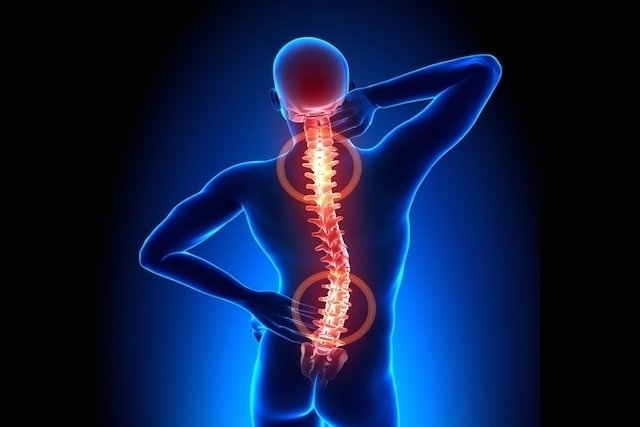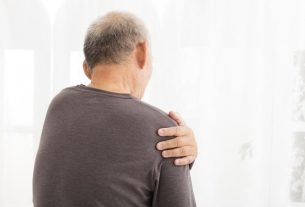Treatment for osteoarthritis in the spine can be done by taking anti-inflammatory medications, muscle relaxants and analgesics. Physiotherapy sessions may also be indicated to alleviate symptoms and prevent the disease from worsening, and as a last resort, surgery to remove the parts affected by osteoarthritis.
Treatment for osteoarthritis of the lumbar spine, which is the lower back region, should be carried out under the guidance of an orthopedist as soon as the first symptoms appear. The treatment for osteoarthritis in the cervical spine, which is the neck region, is very delicate and surgery is only performed in very serious cases.

Remedies for osteoarthritis in the spine
Medications for osteoarthritis in the spine depend on the stage of the disease and the severity of the symptoms. The following options can be used:
- Analgesics and anti-inflammatories: help relieve pain and inflammation like paracetamol;
- Nonsteroidal anti-inflammatory drugs: relieve pain and swelling like ibuprofen and naproxen;
- Medicines that prevent spinal wear from worsening: chondroitin and glucosamine;
- Anesthetic blocks or corticosteroid infiltrations;
- Application of analgesic and anti-inflammatory ointment: are applied to reduce local pain, such as moment or gerarn.
It is important to note that the time, quantity and type of medicine most suitable for treating osteoarthritis in the spine must be defined by the doctor.
Physiotherapy for spinal arthrosis
Physiotherapy for spinal osteoarthritis depends on the symptoms presented and the progression of the disease. The resources used by the physiotherapist include:
- Application of crushed ice wrapped in a damp towel to the spine: must be done in an initial and acute phase to relieve pain;
- Application of hot water bags in the column: can be used in a more advanced and chronic phase to relax muscles and relieve pain;
- Use of devices to relieve pain and inflammation: TENS, microcurrents, ultrasound, short waves, laser;
- Terapia manual: is done through stretching, stretching and joint mobilization with the aim of improving movements;
- Strengthening the muscles of the spine and legs: it must be carried out gradually, in a phase with little pain, to give more firmness to the joints and so that the symptoms do not worsen;
- Hydrotherapy and/or swimming: exercising in water brings many benefits as it relieves symptoms and helps to reduce weight;
- Posture correction: techniques such as Global Postural Reeducation (RPG) and Pilates can be used, aiming to reduce spinal overload, improve alignment and strengthen muscles;
- Osteopathy: is a technique that must be performed by a specialized physiotherapist through manipulations of the spine to reduce friction between the joints. Not all cases of spinal arthrosis can benefit from this technique.
Physiotherapy for spinal osteoarthritis should always be carried out under the guidance of a physiotherapist. It can be performed in a physiotherapy clinic daily and at a later stage, when symptoms are more controlled, it should be done at least 3 times a week.
In addition to physiotherapy and taking medication, the patient must adopt some preventive measures so that the wear and tear on the spine does not worsen, such as avoiding carrying weights, always maintaining correct posture and resting whenever there is any pain or discomfort in the spine.
Spine osteoarthritis surgery
Surgery for osteoarthritis in the spine is only indicated as a last resort, when the pain is disabling, when the neurological part is compromised and when all existing treatments have been tried without success. The surgery options are:
- Fusion of affected spinal segments: the vertebrae that cause the pain are fixed using bone grafts, rods or metal screws. This will limit movement in the affected area and reduce pain;
- Artificial disc replacement: is a more recent technique, performed when there is a herniated disc associated with osteoarthritis. The disc is replaced with a metal prosthesis so that the joint maintains movement and reduces pain.
Patients with osteoarthritis in the spine should always try conventional treatments before proceeding with any type of surgery as not everyone has indications for spinal surgery and there are risks and complications such as damage to the nerves, nerve roots or spinal cord, risk of infections and greater wear on vertebrae that were not operated on.

Sign up for our newsletter and stay up to date with exclusive news
that can transform your routine!
Warning: Undefined array key "title" in /home/storelat/public_html/wp-content/plugins/link-whisper-premium/templates/frontend/related-posts.php on line 12
Warning: Undefined array key "title_tag" in /home/storelat/public_html/wp-content/plugins/link-whisper-premium/templates/frontend/related-posts.php on line 13



